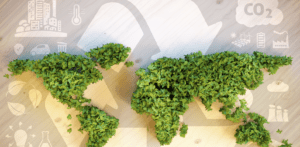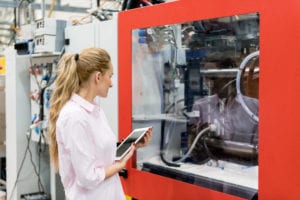The COVID-19 crisis will transform industry. New circumstances have reinforced the importance of agility, efficiency, and resiliency. Our industries are simultaneously needing to save costs while building more capacity and robustness. To achieve both, there is one solution: digitization. But this is not new to industry. Digital transformation was in motion well before the pandemic hit. During the crisis, those who were fully connected had a significant edge. And those who were not, are now trying to catch up. COVID-19 has been a massive accelerator of digital, reinforced by the core needs of remote everything, resiliency, efficiency, and sustainability.
Transitioning to remote everything
Expect everything to become remote. Remote connection and monitoring allow for greater agility, safer working conditions, and higher levels of security. It allows operations to continue without disruption, while abiding by social distancing protocols. During the crisis, many industries experienced scenarios of being unable to send workers to site, leading to operational delays. Unmanned operations allow industry to continue even with reduced physical presence. Augmented reality allows operators to monitor and diagnose machine issues from afar. Virtual reality allows operators to undertake virtual training and visit sites without physically entering them.
Take Baosteel Group, a modern iron and steel company in Shanghai, which created the first truly unmanned hot rolling workshop. During the lockdown, due to their digitization program, they were able to continue operating ensuring both business continuity and the safety of their operators.
Remote technology not only advances processes, it empowers people. On the shop floor, technology including simulations and augmented reality, resolve issues faster. It maximizes support in operations and builds collaboration, allowing sites to connect with talent around the world to get the deepest experience and training.
Resiliency has risen to the top
This will not be our last crisis. Whether it be a due to health, politics, or disasters, we need to step up resiliency to be able to overcome them. In our installations, industry needs to focus on three factors: connectivity, predictiveness, and preventiveness. With connection comes the ability to monitor. Then, using software and analytics, operators can predict future issues which are flagged to services to fix before they become an outage.
But the robustness of an installation is only as high as the weakest point in a facility. Every company is a combination of a value chain including access to the grid, power distribution, building management, IT management, and process management. A break in any one of these links will weaken resilience. Therefore, across the whole chain, automation and analytics need to be implemented. With automation, problems can be solved at the local level without human intervention. With analytics, data can be extracted from the installation to indicate where the service is required.
Enel, an Italian utility, is at the forefront of digital transformation. When energy demand during lockdown decreased dramatically in industry and increased sharply in residential, Enel could manage, in real-time, energy distribution from their remote O&M control center. This is how resilience ensures business continuity during crisis.
Accelerating efficiency
Efficiency has always been critical for industry. But in the wake of the crisis, it is even more relevant as industry is looking for new ways to reduce costs. Digitization is efficiency, and efficiency can be achieved through four axes of integration.
First, the integration of energy and automation, to achieve the two core foundations of efficiency: energy and process. This allows cost reduction while curbing carbon emissions and resource consumption.
Second, the vertical integration of end-point to cloud, connecting every point in an installation from the shop floor upwards, so data is accessible and transparent in real-time.
Third, lifecycle integration, from design and building, to operation and maintenance, eliminating all discontinuities and inefficiencies in the transition from CapEx to OpEx. This enables a seamless collaboration as well as a lifecycle integrity of all data.
Lastly, shifting from the traditional way of managing a company side-by-side, workshop-by-workshop, site-by-site into a Unified Operation Center integration for a big-picture view of energy and resource consumption. This enables a complete benchmark of all facilities and the optimization of every company on a global scale.
Reaffirming sustainability as a priority
The crisis has made us realize we are facing fundamental threats. Both COVID-19 and Climate Change are primary threats to society created as a result of the demographic boom, entailing accelerated urbanization and people concentration. People are more aware of the need for a sustainable world. We need to focus on accelerating the momentum that was already underway to limit global temperature rise to 1.5 °C.
The journey to sustainability begins with digitization. Everything needs to be measured in order to be optimized for efficiency. Using this data on energy and resource consumption, companies are able to develop a strategy focused around efficiency, electrification, circularity, and decarbonization, which they then can execute and iterate. The journey to sustainability is a marathon without a finish line. Every company can do better, and be more sustainable, in the way they do their business.
Trust and partnership: building the foundation for our future
The crisis has taught us trust and partnership are the golden foundations of resiliency. Sanitary risks created fears and suspicion, but the countries, societies, and companies that were most successful during the crisis were the ones that worked with the highest standards of trust. On that trust, they developed an empowerment of local people to make local decisions. These two factors – trust and local – are our strongest indicators of performance, including resiliency, reactivity and capacity to be performing again faster. We strengthened many relationships during the crisis through trusting each other, simplifying processes and avoiding micromanagement in many places. We need to take these learnings and build on them as a new way of working in the future.
COVID-19 has not changed the fundamentals but emphasized the need for agility and adaptation. In an economy under pressure, in a fragilized world, it is a call for awareness, efficiency, and sustainability.
To realize these essentials, trust, partnership, and digitization are paramount.




Conversation
I understand the need to minimize the effect of the virus. Protecting our employees so we can maximize productivity for our customers’ needs is vital. We must understand that the virus cannot be stopped. Now that the therapeutics are showing great results and a vaccine is on the horizon the time for being afraid of this virus should be a thing of the past. Do you think that it might be time to loosen some of our preventative restrictions?
Best Regards,
David R. Wilson
Thanks for the article Jean, it’s inspiring.